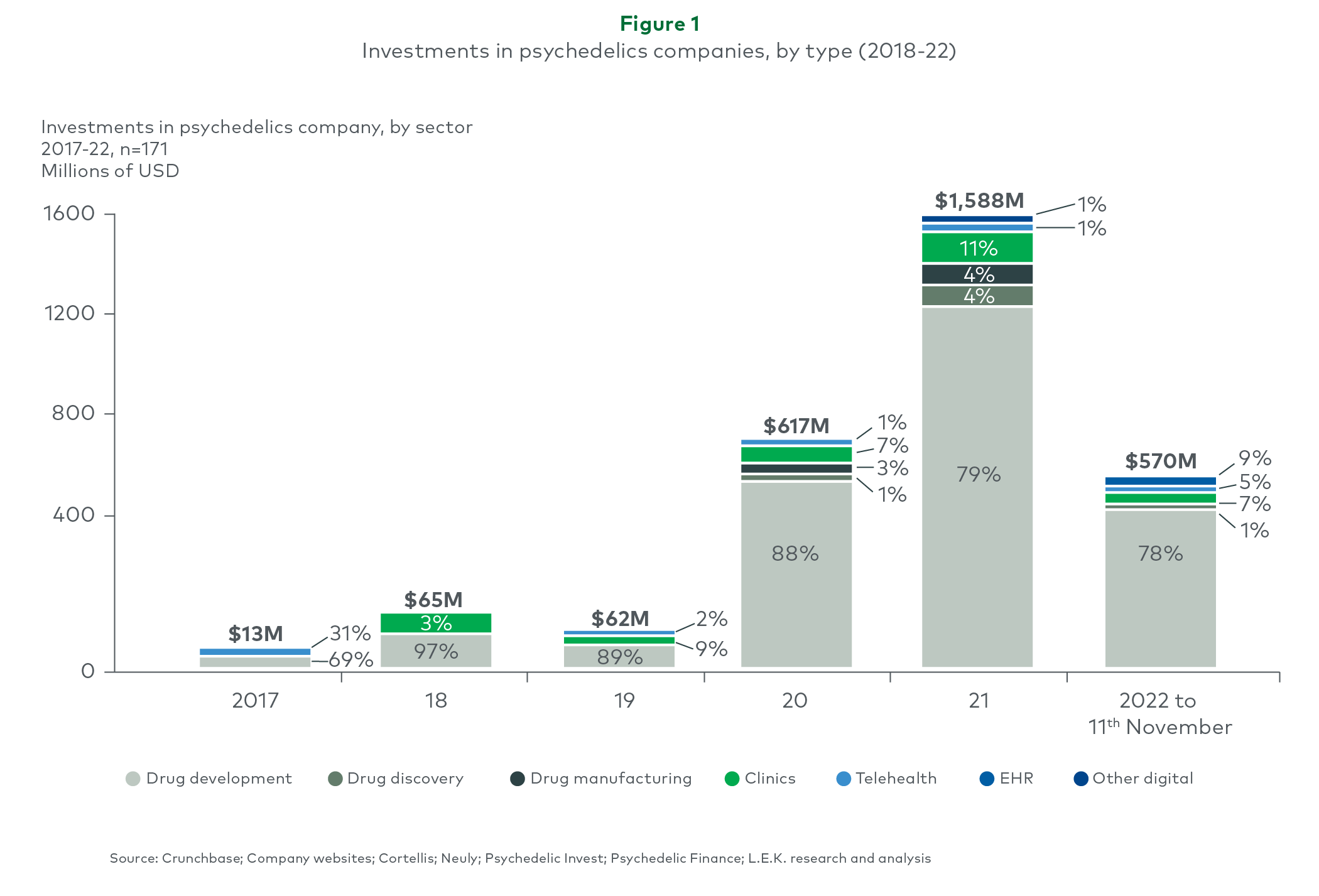Pressing Pause on Psychedelic Cash: Analysing the Challenges in Psychedelic Drug Development Through Investment Trends
The development of psychedelic drugs for the treatment of mental health conditions has attracted a flood of funding over the past five years, with over $1.5 billion invested in the sector in 2021 alone (see Figure 1). This investment has been driven by recognition of the considerable commercial potential of psychedelics for mental illness, an area of high unmet need further exacerbated by the Covid-19 pandemic. Closer analysis of the patterns of this funding can help illustrate the specific challenges facing the development and commercialisation of these novel products.
Figure 1: Investments in psychedelics companies by type (2017-22)

Today there are over 50 psychedelic compounds in clinical trials, with around 15 ongoing Phase II trials1. This progress has been strongly supported by cash flow into start-up drug development companies, with a boom in funding during 2020 and 2021 led by high-performing IPOs2. However, these investments now face a clear test, and a resulting pause in further investment as investors wait to scrutinise crucial clinical trial results due in late 2022 and early 20233. This moment of reckoning is a significant factor in 2022’s more modest stream of psychedelic investment, with around $570 million invested to date.
While the funding for drug development may have slowed down in 2022, the story for other companies in the psychedelics sector is notably different and reveals the breadth of challenges facing the development of psychedelic drugs. While in 2020 psychedelic companies outside of drug development accounted for around 10% of all investments in the sector, today these companies comprise almost 30% of investments. Around $100 million of funding since 2020 has been directed to companies setting out to solve challenges in running psychedelic clinical trials through manufacturing and clinical trial support. This includes new psychedelic drug manufacturers with licenses to handle and distribute Schedule 1 controlled substances, such as Psygen4, and clinical trial organisations with expertise in frameworks for running successful placebo-controlled trials with hallucinogenic substances, such as Clerkenwell Health5.
Other funding streams are directed at companies thinking beyond clinical trials, to the successful commercialisation and delivery of psychedelic drugs. Given that psychedelic drugs are currently developed as part of a psychedelic-assisted psychotherapy package, this is as critical to the commercial success of psychedelics as the scientific and clinical evidence for the drug compound itself. To provide safe and efficacious psychedelic-assisted psychotherapy, and to ensure patentable protocols for decades-old compounds, strict protocols must be followed for each compound by specially trained therapists in standardised clinic settings. These requirements are reflected in the establishment of training providers for psychedelic-assisted psychotherapists, such as Fluence6, as well as the steady funding of clinic networks in the U.S., such as Field Trip Health7, currently focused on ketamine-assisted psychotherapy, although poised to switch to psychedelics upon approval8.
Figure 2: Psychedelic-assisted psychotherapy protocol

However, the current level of funding is unlikely to fully resolve the core challenge in commercialising psychedelic drugs: capacity within the mental healthcare system9. Through analysing the therapeutic protocols of psychedelic compounds in Phase II and III development (Figure 2), the level of infrastructure required to deliver psychedelic-assisted psychotherapy is high. On average, around 40 hours of therapist time will be required for a single dose of psychedelic drug when considering preparation, dosing and integration sessions. Although this requires fewer healthcare resources than a course of electroconvulsive therapy10 or transcranial magnetic stimulation11, the potential addressable patient population for psychedelics is significantly higher.
Looking forward, the key inflection points in the development of psychedelics will come in the form of Phase II and III clinical trial results, followed by the establishment of commercial infrastructure for their delivery. As these results materialise, and companies continue work on developing next-generation psychedelics with improved properties and increased patentability, more traditional biopharma players are likely to enter the space. Pharma companies may capitalise on this opportunity to enter an historically challenging therapeutic area through mutually beneficial arrangements providing access to innovation in exchange for commercialisation support.
Learn more about L.E.K. ‘s Life Sciences Practice or contact L.E.K. Partner, Adrienne Rivlin at a.rivlin@lek.com
- https://psychedelicalpha.com/data/psychedelic-drug-development-tracker
- https://psychedelicalpha.com/news/looking-ahead-to-a-psychedelic-2022
- https://pitchbook.com/news/articles/psychedelic-ipos-build-momentum-as-atai-life-sciences-goes-public
- https://psygen.ca/manufacturing/
- https://techcrunch.com/2022/10/10/clerkenwell-health-raises-2-1m-to-test-the-new-wave-of-psychedelics-treatments/
- https://www.prweb.com/releases/fluence_raises_3_million_to_scale_psychedelic_therapy_training/prweb18492612.htm
- https://www.fieldtriphealth.com/
- https://www.vox.com/recode/22716491/psychedelics-ketamine-mental-health-research-fda
- https://www.clerkenwellhealth.com/blog-articles/solving-the-therapist-bottleneck
- https://www.frontiersin.org/articles/10.3389/fpsyg.2016.00790/full
- https://www.ncbi.nlm.nih.gov/pmc/articles/PMC4808718/
